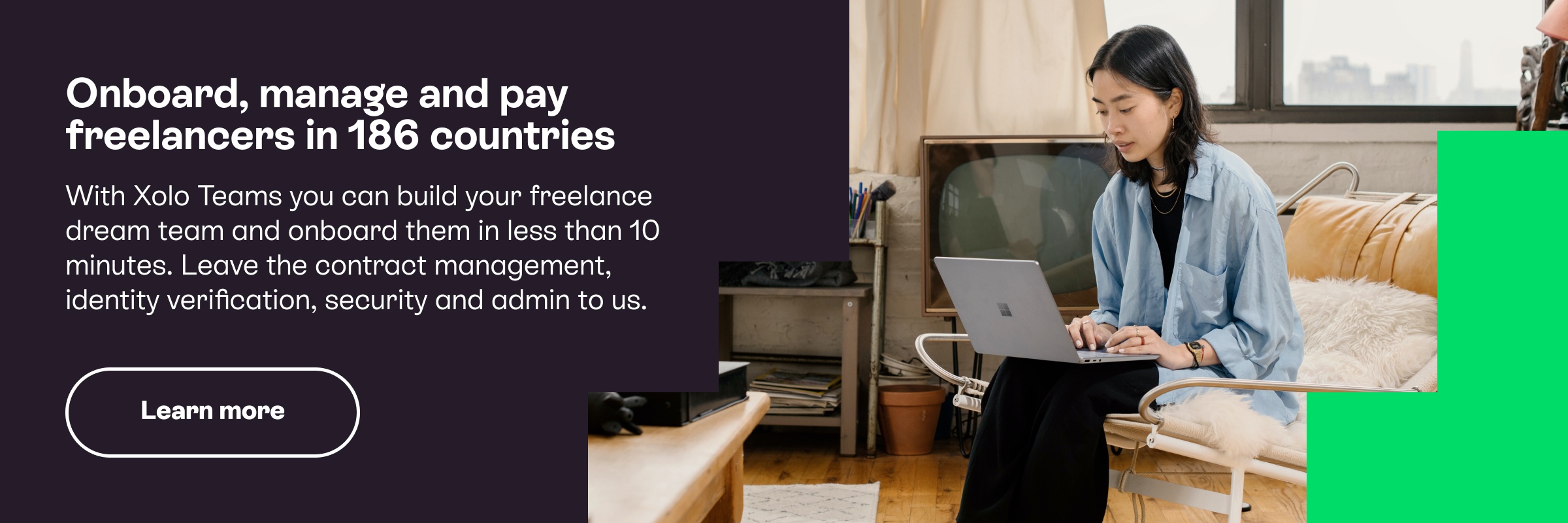How to onboard freelancers & independent contractors

on May 13, 2022 • 9 minute read

As the talent market remains white-hot, you need to be decisive when it comes to hiring and retaining your best people. This includes your freelancers and independent contractors.
Data from all over the world says that the demand for freelance services is up. Globally, 45% of freelancers saw an uptick in demand for their services last year. In the Middle East, Northern Africa (MENA) region, up to 80% agree that the volume of freelance work is higher at the moment.
The surged interest in freelance services is unsurprising. Pandemic-prompted transition to hybrid work made the idea of hiring remote contractors less “alien” even to large enterprises. Likewise, many workers choose to ditch corporate jobs for self-employment as part of the “Great Resignation”.
This year, 46% of HR professionals expect at least 20% of their workforce to be made up of contractors or temporary workers. On social media, the “we are hiring” calls get more urgent for all sorts of jobs — from content marketing to UX designers.
In other words: the talent market is scorchin’ hot and you need to hold on to your people.
But let’s say you are ready to hire your ideal freelancer and want to keep ‘em around for the long-term. How do you do that?
We break down the best practices in this guide to onboarding freelancers and contractors.
What is freelancer onboarding?
Freelancer onboarding is a set of formal steps you take to provide new freelancers (independent contractors) with all the information they need to settle in successfully.
Modern onboarding practices stemmed from an earlier concept of “organizational socialization” — a theory, proposed by two MIT professors in the late 1970s. The duo argued that:
From the time individuals first enter a workplace to the time they leave their membership behind, they experience and often commit themselves to a distinct way of life complete with its own rhythms, rewards, relationships, demands, and potentials.
And they attempted to understand how “long-standing rules of thumbs [....], models for social etiquette and demeanor, certain customs and rituals…” are developed within the organization and transferred between one member to another.
Or in modern terms: why everyone at your office might prefer a fist bump to a handshake or never touch the last carton of milk in the shared fridge.
In 2022, many of us no longer have an “office”, in its traditional sense. Yet, every workplace still has a set of “rituals”, reverently observed when it comes to day-to-day work. For example, no meetings before 9 a.m. or mandatory NDAs for all software development roles.
Freelancers, joining your ranks, are in the dark about those things. Therefore, you need to build a freelancer and contractor onboarding process to loop ‘em in on main ‘customs’.
At the very minimum your freelancer onboarding checklist has to cover four major areas:
- Administrative. This includes all the paperwork your hire needs to sign in order to work with your organization legally — work-for-hire contracts, NDAs, the scope of work documents, and the like.
- Financial. Next, you must get on the same page when it comes to payments — sums, schedule, methods, etc. Don’t forget about tax data collection (if needed).
- Organizational. Get your freelancer up-to-speed on all operational matters such as deadlines, reporting schedule, preferred communication channels, collaboration tools, etc.
- Social. Finally, make your new assets feel welcomed by doing a round of intros and a general orientation. Provide information about the company, key services, project, team composition, and so on.
The faster you do the above — the sooner productive collaboration can begin!
The importance of freelancer and independent contractor onboarding
To onboard freelancers effectively, you need a repeatable system for completing standard administrative, compliance, and introductory formalities.
Yet only 12% of companies offer a great onboarding experience for employees, let alone freelancers. That’s a huge oversight because poor onboarding directly affects employee retention.
As MIT social scientists argued back in the 1970s and HRs agree today — strong social and emotional connections between workers and their workplace is crucial for keeping people on board.
When that doesn’t happen fast enough, many call it quits. SHRM suggests that employee turnover can be as high as 50% in the first 18 months for in-house hires.
Independent contractors and freelancers will need even less time to churn.
Remember: freelancers run a business. Their time equals their income. The longer you drag the onboarding — the less engaged your prospect becomes.
Every freelancer has a list of client red flags — ranging from low pay to wild expectations or too tight deadlines. Many will refuse collaboration at the early stage. Others may tolerate several “strikes”. But with no shortage of freelance jobs, the busy pro will move on to the next best offer if you make them jump through too many hoops.
And this takes you to square one where you once again need to go through the lengthy freelance hiring process.
Apart from losing talent, a haphazard onboarding freelancer process (or lack of thereof) also leads to other disadvantages:
- Delayed project start date and services delivery
- Recurring miscommunication and reworks, causing frustration
- Low engagement and subsequent exit from the project
- Late fees, charged by the freelancer due to late payments
An effective onboarding system for independent contractors helps set clear expectations on both ends and reduces time to value creation.
Moreover, it helps you retain your key freelance hire(s) with more means than just money.
We, Millennial freelancers, do care about good compensation (‘cause there are bills to pay). But we also connect with teams and projects on an emotional level. We stay on projects we like and care about — and with the people with whom we cultivate meaningful connections (going beyond task update emails and payment notifications).
Such emotional connection is central for retaining both in-house employees and contract hires. A Pepperdine University study found that thoughtful onboarding can increase productivity and reduce unwanted turnover by as much as 50% in the first two years — while a sloppy one increases turnover by the same value.

How to onboard freelancers and independent contractors in 6 systematic steps
While organizational socialization focused more on ‘soft’ cultural factors, the modern version of onboarding is rather methodical.
Onboarding is a system of consecutive steps each party — the freelancer and the client — has to complete.
We break these down below with some extra freelancer onboarding best practices for each stage.
1. Prepare freelancer work contracts
Every new collaboration should begin with contract counter-signing. That’s “good business 101”. Sure, paperwork isn’t really fun. Make this step fast and effective by creating a standard set of legal assets for co-signing.
Your contracts for freelancers should include:
Standard work-for-hire templates:- For short-term, one-off projects
- For ongoing, retainer-based work
- Non-disclosure agreement
- Non-compete/conflict of interests (if applicable)
- Other special provisions
Here’s what a good freelancer work contract should include:
- Names of all parties
- Agreed work scope and deliverables
- Pre-agreed deadlines or timelines
- Freelancer pricing structure/rates
- Payment terms and conditions
- Kill, cancelation, or late fees
- Ownership rights and copyright agreements
- Liabilities and indemnities of each party
Depending on your line of business (and compliance rules), you might need to add some extra clauses. Check-in with a legal professional to help you craft the optimal contract structure.
Store all the created legal templates in one place and get an account with an e-signature service to quickly co-sign all documents.
When it comes to taxes, the general rule is that independent contractors (freelancers) are responsible for filing their own taxes. The only tax you may have to pay is VAT (in Europe) and sales tax in the US (if applicable). Should you need any information for local tax reporting, be sure to request it from the freelancer in advance before actual work begins.
2. Set up payment processes for your freelancers
In our day-to-day lives, paying for things is easy. A card swipe, a phone tap, or a button click, and you are done.
Yet, paying freelancers often is an issue for businesses — even with a plethora of payment tools available. Rigid internal accounting practices stand in the way. Almost 40% of small businesses say that their funding and accounting structures aren’t conducive to continual payments to freelancers.
Larger organizations are no better. I once had a client in the publishing industry who needed over 8 months (and three separate registrations in their vendor system) to process my paycheck. Not cool.
Ask your accounting team what payment tools or process optimizations they need to make in order to process freelancer payments quickly.
Then get back to your freelancer to:
- Agree on the preferred payment method
- Decide who covers the processing fees
- Develop a convenient payment schedule
These three elements are central to fast freelancer payouts.
Make sure that the proposed payment method works for you. Cross-border payments can be a bit of a nuisance as some banks charge exorbitant wire transfer fees. These can add up fast for bulk payments. Research the payment costs in advance.
Also, if you need the contractor to complete any type of internal registration, ask them to do so now. Don’t be that person who says “oh, I forgot to mention that you need to complete this 27-step form to get paid” only when the freelancer sends over the invoice. This will cause a lot of frustration.
Finally, if your end goal is to run a larger freelancer team, you’d really need to automate and streamline your accounting. Or else, there will always be payment issues and mounting dissatisfaction. Xolo can help you with this. We allow you to handle compliance, payroll management, and bulk freelancer payouts — all from one convenient interface and for a flat 5% per payout fee.
3. Create a freelancer welcome package
What does your company do to welcome new hires? My guess is you probably tour the newbie around the office (if you still have one), hook ‘em up on a team meeting (or group Zoom call), and then pass them onto the manager for training. During the first week(s), the newbie will be assigned with a mentor (formal or informal), invited to meetings, and otherwise trained and entertained.
With freelancers, you don’t have the luxury of several weeks for doing the ‘meet and greet’.
Still, you should provide a more condensed “welcome” experience. The easiest way to do so is to pack this in a digital welcome package — an email, Google folder, or a Notion page with the following details:
- General company overview — give some background on your mission, vision, and project goals.
- Supporting project information — briefs, documentation, technical guides, style guides, and other relevant docs, neatly organized in one place.
- Relevant training materials — quick video tutorials, checklists, or SOPs that help your freelancers better understand your ways of work.
- Communication schedule — explain when you’d like the freelancer to check in and which channels to use for reporting.
- Key contacts — list the main liaisons for this-or-that. Typically, you should provide one main point of contact (direct manager) + emergency contact (e.g. an HR member).
- Access to tools and tech — share log-in details to the necessary tools or send over invites to guest accounts.
Pack all of the above in a “welcome page” and share it with every new contractor. It will save you a lot of time on answering redundant questions or being chased down for important project information.
That being said: do add some “human touch” into your freelancer welcome package.
A group of UX researchers found that a lot of freelancers have an “icky feeling” when they are joining a new project and hate “feeling like a dummy on the first day”. Don’t let those feelings become the norm. Apart from orienting new freelancers, think of some quick ways to give a virtual heartwarming greeting.
Here are some wholesome ideas for your contractor welcome package:
- Leave a personalized “glad you joined!” voice or video memo using Loom.
- Make a short “How to work with me” guide with a Manual of Me app.
- Share a funny picture of you, your desk setup, or your pet.
- Add your favorite Spotify playlist you tune in for productive work
Such small personal gestures can go a long way into making your freelancer feel truly welcome!
4. Host a freelancer kickoff meeting
After your freelancer went through all the project deets, offer to host a short quick-off meeting.
This shouldn’t be a rigid rule, but rather one of the contractor onboarding best practices for longer, more complex projects.
During this short meeting, go through any questions the freelancer has so far. If you can’t provide the details, give them a cheat sheet of people to reach out to instead. Or source the required information yourself.
Remember: the best managers are facilitators aka people who remove blockers and make things move faster, rather than just issue directives or expect the person to “just figure it out”.
5. Show, rather than tell, what good work means to you
The main purpose of onboarding is to get your contractor on the same page with the rest of the team. You need them to understand what great work means to you.
But ‘great’ is a vague describer, so try to put your requirements into more concrete terms. The easiest way to do so is by providing references.
An extended version of your independent contractor onboarding checklist should include:
- Relevant references such as examples of content, visuals, designs you like with quick notes on what you fancy. Or access to the internal brainstorming your team did earlier.
- Quality standards — these should be more measurable requirements a freelancer can easily meet e.g. an A+ scope on an SEO tool or an average email open rate of at least 12%.
- Benchmarks. Show what types of results your team got on previous campaigns and explain how you got there. This gives your freelancer another reference point and helps them replicate your results (and perhaps even top them!).
- Personalized KPIs — to help freelancers understand how their success will be measured. Word of caution: don’t get overly obsessed with low-level numbers as they might distract you from the bigger picture.
Remember: If you can’t succinctly communicate your needs and preferences to an ‘outsider’,
you are probably having internal communications issues too. So use freelancer team expansion as an opportunity to improve your team’s operating processes.
Working with freelancers sets a good precedent for creating better-documented processes and improving your internal knowledge management.
6. Ask for freelancer’s feedback
Every HR team loves doing employee surveys. When done right, surveys can help you figure out how to make your teams happier and more productive. And notice the early signs of churn. So incorporate a “feedback loop” into your freelancer onboarding process too.
Asking your contractors for occasional feedback helps:
- Develop trust on both ends
- Maintain high engagement
- Improve overall operational efficiency
You don’t have to fashion this into a 2-hour performance review. Instead, set a reminder to pop in with a quick “hey how are you doing and what we could do better?” message. A good time for a feedback session is either post-project completion (for smaller tasks) or after reaching a key milestone (for longer projects). Overall, it’s a good idea to ask for contractor feedback every 6-8 months.
Final Thoughts on Freelancer Onboarding
Many companies inadvertently make a mountain out of a molehill whenever they need to onboard contractors. Sure, you want to protect yourself from all sorts of legal, tax, and compliance risks. But your “playing it safe” can restrain your access to talent.
To recap, here’s how to compliantly onboard freelancers:
- Co-sign a work-for-hire or independent contractor agreement
- Collect the freelancer’s payment details and agree on the payment schedule
- Clarify with your accounting on any extra steps are needed for tax/compliance purposes
- Consolidate all relevant project information in one place and share it with the freelancer
- Host a kick-off meeting to further orient your new hire and answer their questions.
- Keep collecting freelancers’ feedback to further improve your freelancing process.
And those who want to shave off the first three steps from this to-do list, Xolo is the tool to check next! 😉
About Elena
Elena Prokopets writes content for tech-led companies & software development businesses, marketing to them. Her empathy for the customer, expertise in SEO, and knack for storytelling help create content that ranks well and drives industry conversations.
Elena uses Xolo so she can focus on her solo B2B content writing business without stressing over the compliance and admin overhead.
Related blogs
Subscribe to
our newsletter
and get the latest updates and expert
business tips straight to your inbox.

